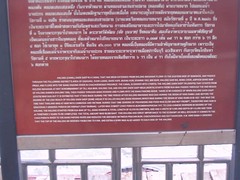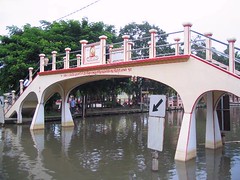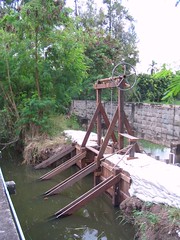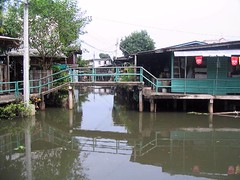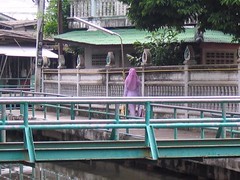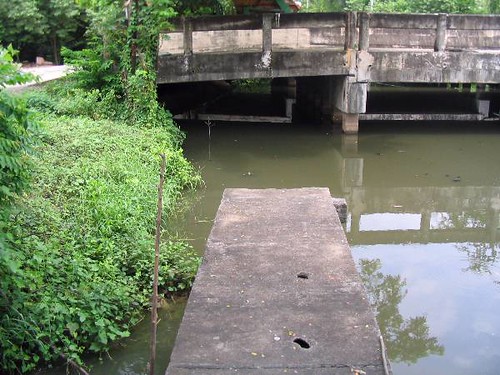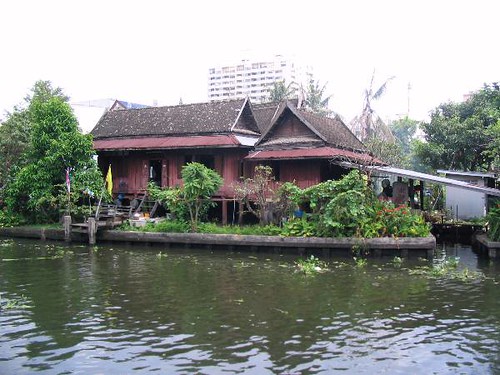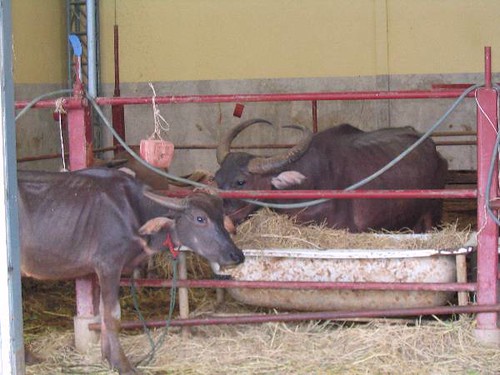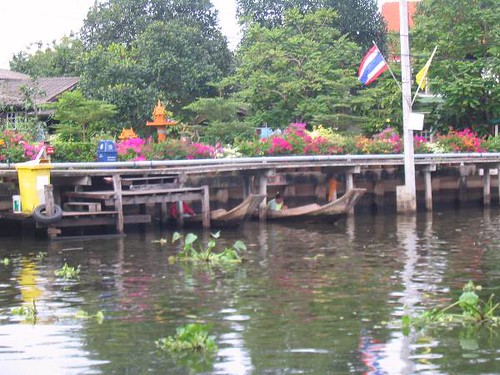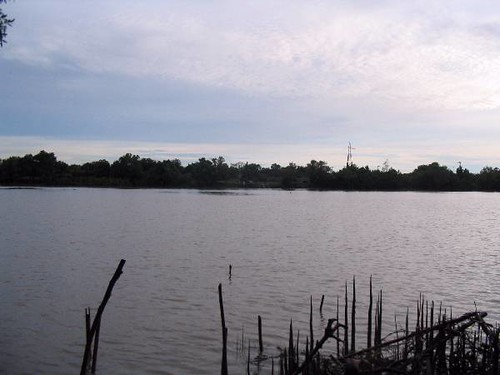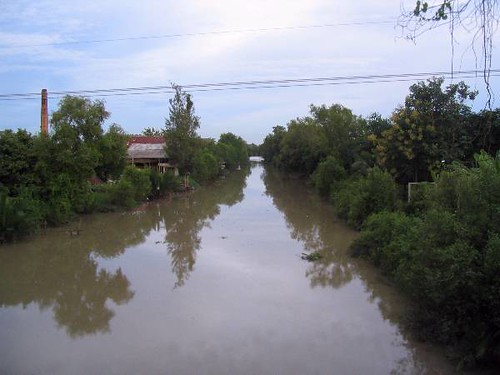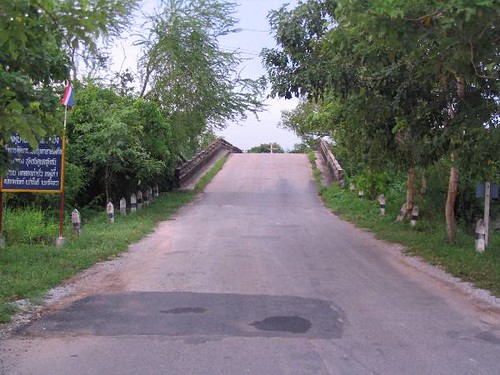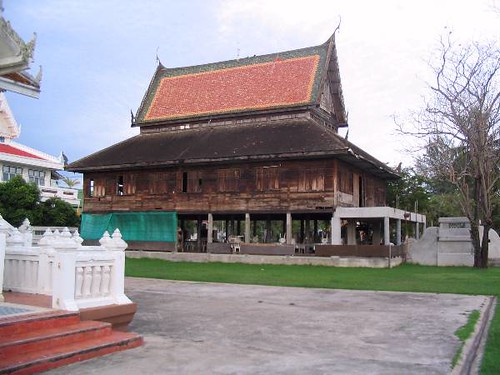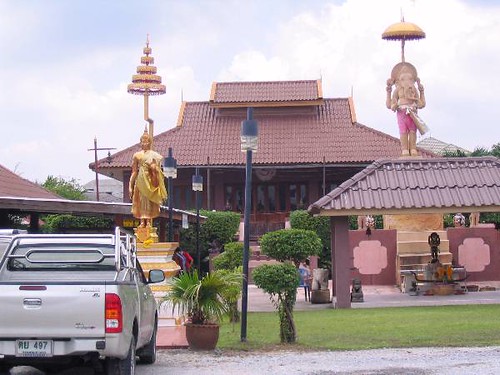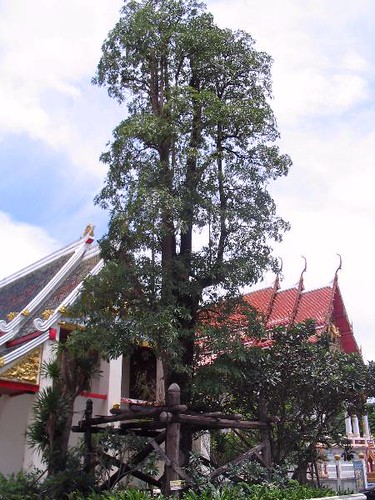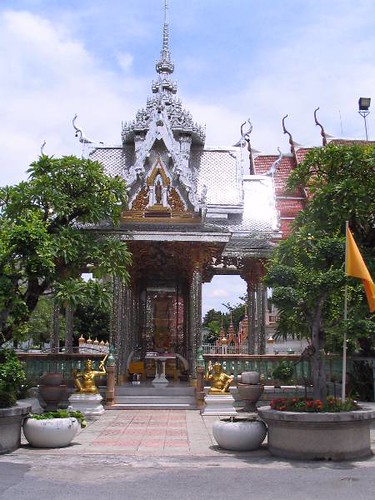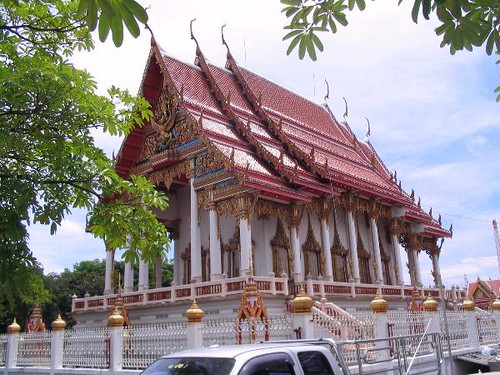Friday, September 28, 2007
More on Burma
So how about economic sanctions on those countries that do not take economic sanctions themselves against Burma. Even if this not enough to convince China it should help with those Asean countries like Singapore, Indonesia and Thailand.
If there is again an escape into the jungle by protesters, let's have a promise of aid, including arms, and asylum for those asking for it.
Wednesday, September 26, 2007
Crocodile Tears for Burma
Unless some of the younger army officers decide that their prospects are better under a democratic government there will be real tears soon. The Burmese generals have never been slow to kill their own people.
Even if the Chinese will not listen, Britain, America and the EU could lean on the governments of India, Thailand and Singapore and make sure the generals have nowhere to spend or keep their money. Let's also have some Western financing for the Karens and the student groups to keep on fighting.
Klong Saen Saeb History
Khlong (canal) Saen Saep is a canal that has been extended from Khlong Mahanak flows to the eastern side of bangkok, and passes through the following district's area of Vadhana, Suan Luang, Bang Kapi, Bueng Kum, Khanna Yao, Min Buri, Khlong Sam Wa, Nong Chok, Amphoe Bang Nam Priao, and flows into the Bang Pakong River in Chachoengsao Province. The canal is devided into 2 parts; the Khlong Saen Saep Tai (South) that starts from Khlong Mahanak at Wat Borommaniwat up till Hua Mak, Khlong Tan, and Khlong SaenSaep Neua (North) starts from Hua Mak passes through the end reach of Khlong Samsen (Khlong Tan), then passes through Bang Khanak and flows into the Bang Pakong River. There is no evidence of when Khlong Saen Saep (South) was dug but it is estimated that it was made during the time period after Khlong Mahanak was dug during the reign of King Rama I and before the digging of the end reach of Khlong Saen Saep (some areas ity is called Khlong Bang Khanak) which was during the reign of King Rama III in 1837. This was the time that Thailand was at war with Cambodia and Vietnam. During that time sending of provisions and food was slow and not prompt. Therefore King Rama III graciously ordered Phraya Sri Phiphat (That Bunnak) - later was Somdet Chao Phraya Borrommahaphichai Yat, to lead Chinese workers in digging up the khlong. The khlong started from Hua Mak up till Bang Khanak, a total length of 53.519 Kilometres, and had a width of 6 wa and a depth of 4 sork and took altogether 3 years to be completed. The total amount was 96,000 Baht. this khlong has great importance to the economy as well because it connects the Chao Phraya River to the Bang Pakong River and reduces the distance between Prachin Buri, Chachoengsao and Rattanakosin. H.M. King Rama V ordered that the top of the khlong be widened from 6 wa to 9 wa and an extra 6 sork was also added to each side of the khlong.
The Thai measurements in the above piece work out as follows. A Wa is about 2 metres which is fingertip to fingertip with spread arms. A Sork is from the elbow to fingertip, a bit less than half a metre.
Monday, September 24, 2007
Sunday's Walk
The main canal is wider than our local Klong Prawet Burirom at least as far as the watergate just before Minburi. After that it does narrow by about a half. I walked east but the path run out before the watergate. Turned and went as far west as the path on the southern bank goes. This was opposite a mosque and there was a bit more footpath on that bank but now way of getting there easily. Not much to report on this walk as it was quiet and not many people were about.
Looking east towards the watergate from the eastern end of the footpath
Looking west towards the ring road from the western end of the footpath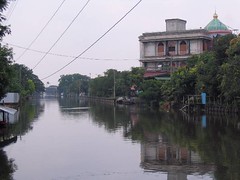
After I drove to the other side of the watergate and parked at Wat Bumpennua. The bridge crossing the canal is unusual and very Chinese looking.
Saturday's Football
Friday, September 21, 2007
New Local Walk
Anyway in the map below you can see it shown in blue dots. I had walked as far as I could on the southern end before and then realized, after I crossed under the motorway, that I had also walked the last couple of hundred meters on the northern end before. About the most interesting thing on this walk was having to take my shoes off to paddle through two flooded sections. The night-time rains have been heavy this last week. I did notice some more traditional style Thai houses by the side of this canal. There are far more of these than I would have thought a year ago.

Wednesday, September 19, 2007
More Football
Yesterday and today still busy. Did get out late morning and have my often used walk, 50 minutes along Klong Banma from the top of my street. Still wondering about that new watergate. I will add a picture below. There are now two large pumps on the lake side of the gate and a watchman living in a small shelter.
Monday, September 17, 2007
Bad Monday
I'm thinking about a drive up north sometime this or next month. We have a free Chiang Mai hotel voucher to use and although flights are cheaper than driving I do like the independence of a vehicle. Wait and see how am I am in a couple of weeks.
Sunday, September 16, 2007
Yesterday's Football
Klong Lam Sali Walk
Although only a couple of kilometres away today's walk was totally different and far more upbeat than yesterday's. The community by the mosque on Klong Lam Sali where Krungthep Kritha Road crosses has been there a fair amount of time. With well built foot bridges and small shops on the side it was almost like Venice.
I walked up and down this canal, to and from the railway line and east until the footpath stopped at the road opposite the Krungthep Kritha Golf Course. About 5 kilometres in total. I will mark this area on a map soon as I can find some more walks heading north towards Klong Saen Saeb from here.
Below was a very fashionable Moslem lady in a light purple trouser suit. I couldn't catch up to get a closer photo.
Saturday, September 15, 2007
 This part of Klong Banma doesn't have much going for it. No old communities on it, just more recent ones. There are new (less than 30 years old) housing estates mainly walled off from the klong and more recent very basic homes of rural migrants. Neither of these groups would produce votes for city hall if the upkeep of the canal footpaths were better. The housing estates because they don't use the canal and the migrants because they can't vote in Bangkok. Hence the footpaths are pretty bad. (I think if I were in city hall I would try and sign up all the rural migrants onto the voting list. Tammany Hall style for sure.)
This part of Klong Banma doesn't have much going for it. No old communities on it, just more recent ones. There are new (less than 30 years old) housing estates mainly walled off from the klong and more recent very basic homes of rural migrants. Neither of these groups would produce votes for city hall if the upkeep of the canal footpaths were better. The housing estates because they don't use the canal and the migrants because they can't vote in Bangkok. Hence the footpaths are pretty bad. (I think if I were in city hall I would try and sign up all the rural migrants onto the voting list. Tammany Hall style for sure.) Wednesday, September 12, 2007
History of two klongs
'Originally it was a natural canal (Khlong) that meandered and connected Khlong Nong Bon to the Chao Phraya River. the approximate length was around 10 kilometres. Khlong (Canal) Phra Khanong was dug deeper in 1837 by Somdet Phra Nang Klao, King Rama III, he graciously ordered Phraya Sri Phiphat (That Bunnak) - later was Somdet Chao Phraya Borommahaphichai Yat, to carry out the digging, so as to improve the communications as well. Chinese labourers were hired and the work completed in 1840. Consequently, King Rama V graciously ordered to dig up Khlong Phra Khanong to be extended and allow it to be connected to Klong Dan that eventually flow out into Bang Pakong River in Chachoengsao province, and this new canal was named Klong Prawet Burirom. The total capital used to dig up the khlong came from three sources. The first source was from King Rama V who donated money from the royal treasury, which amounted to approximately 80,000 Baht and was used to pay the Chinese labourers. The second source was actually Nuea Fin (opium) that was used as a mean to pay the wages. The third source of fund was from the people. The King granted permission to the people to collect and pay part of the cost of the Khlong. The total amount collected was 32,752 Baht. It was the first khlong that King Rama V allowed the people to join in and help pay the cost. The benefits that were granted back to the people who joint in and paid was that they were allowed to reserve land on both sides of the khlong, in the designated areas and according to the amount they paid up. For the amount ranging from 2 Salueng up to 1.5 Baht, which was the higher rate, these people were allowed to reserve land at the top of the khlong. As the rate decreased the area that could be reserved would be further down the khlong, till the area of Chachoengsao province.'
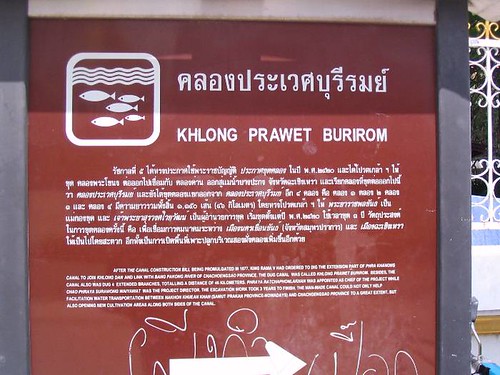
Above - Klong Prawet Burirom Poster
'After the canal construction bill being promulgated in 1877, King Rama V had ordered to dig the extension part of Phra Khanong Canal to join Khlong Dan and link with Bang Pakong River of Chachoengsao province. The dug canal was called Khlong Prawet Burirom. Besides the canal also was dug 4 extended branches, totalling a distance of 46 kilometers. Phraya Ratchaphonlakhan was appointed as chief of the project while Chao Phraya Surawong Waiyawat was the project director. The excavation work took 3 years to finish. The man-made canal could not only help facilitation water transportation between Nakhon Khuean Khan (Samak Prakan province nowadays) and Chachoengsao Province to a great extent, but also opening new cultivation areas along both sides of the canal.'
Klong Ban Ma or Klong Banma
The spelling thing is a problem. I have always used "klong" although now on official signs and much of the internet it's "khlong". The "Prawet" in Klong Prawet Burirom is spelt "Prawes" as the district and I have used Pravet in the past which is closer to how it sounds. For Klong Phrakanong we could use Phra Khanong, Phrakhanong, Prakhanong and so on.
Monday, September 10, 2007
Sunday's Drive
Saturday's Walk
Friday, September 7, 2007
What We Really Want From Our Police
In the sixties it was so much easier. We thought the police were an instrument of the authorities and we would be better off getting rid of them. Not that Ken was ever part of the "Kill the Bill" extreme as far as I know. Mind you there was some truth in the left's views. Certain police stations did have large numbers of BNP or National Front members and synthesizers in them. Rumours always had Bexleyheath as one of these. Also both the Met and the City of London police were riddled with corruption down to the point where robberies were being organized by the police.
Of course very few societies, and I guess no large ones, could exist without policing. In a city like London we would have vigilantes if there was no police. So what are the ideal qualities for the police force?
The easy answer is that the force should represent the views and cultural make-up of the population it polices. A cynic would suggest that usually they represent the views and cultural make-up of the authority that pays their wages and controls their promotions. To me the answer is that we need to individual policemen to be liberal with a small "l". An ability to see more than one side to a problem as opposed to a "string them up" attitude.
With the best and brightest of the young officers now being put on a fast-track promotion ladder is this what we get? Has Ken got it right? I suspect that attitudes more than racial make-up of the force is more important. Having said that, it certainly doesn't hurt having more black and asian faces on the force.
Thursday, September 6, 2007
The Myth of a Professional Army
At the start of the Second World War Britain had a professional army and it proved to be no match for the Germans, being driven backwards down to the beaches at Dunkirk. As the volunteers and conscripts joined the army grew not only in size but in ability. I put this down to the lower grade officers and NCOs now no longer being from the professional army, but being from real life.
What I suspect happened is the army changed from being a professional army to a citizens army. I think what comes with that is increase in both intelligence and common sense along with a sense of purpose. My mother told me that first tranche of conscripts were all 21-22 years old and were called the militia.
The picture at the bottom of this piece is of Tom Wintringham, the founder of the Home Guard. He very much preached the idea of a citizens army and probably scared a few of the pro-appeasement Tories with his threats to string them up. He was a leading writer before and during the war on military matters. He was also an ex-communist and ex-leader of the British section of the International Brigade in Spain which is the tie-in with Frank Ryan. When you read the histories of these guys you have to think there could be a good movie in them. Ken Loach, anyone? If you would like to read more about Tom Wintringham there is a good 2004 book by Hugh Purcell called "The Last English Revolutionary - Ton Wintringham 1898-1949".
Now looking back and trying to pick good examples of professional versus citizen armies is interesting. The American War of Independence was certainly a citizens army against the most professional army money could buy, with all the German mercenaries in red coats. Was Cromwell's New Model Army a citizens army? The Israeli Army is certainly organized on a citizens army basis and there seems to be an improvement even at the very top level. Other countries do this as well; Norway and Switzerland are examples.
Should we do it in Britain? I suspect where it doesn't work is when you ask a citizens army to fight in a foreign country that poses no threat to their homeland. I don't think it worked that well for the Americans in Vietnam and I don't think it would work that well for us in Iraq or Afghanistan. A citizens army is basically a defensive army and not suited to an aggressive government intent on using military might to sort out political problems. Probably professional armies do this better.
If we had governments who stayed out of conflicts of the Iraq type, that is a bit like Harold Wilson who would not get involved with the Vietnamese War. Could they convince us that some sort of conscription would be a good thing? I could see ways in which it would bring all the ethnic and religious sections of British youth together for a while. It's no good me saying it though as I never had to suffer conscription, it had already ended by the sixties. Has our professional army officer corps improved that much since the war? I doubt it and suspect we will still get too many public school boys in it.

A Quick Peep at Klong Saen Saeb


Tuesday, September 4, 2007
Fallen Heroes
Radio 7 had been repeating this series from, I think an original Radio Ulster program. They cheated a little by putting two of the seven and half minute episodes together so it only took 120 weekdays. It finishes in the 1930s. I was hoping to hear something about Frank Ryan, but although they did have a little on his enemy Eoin O'Duffy they ended just before Ryan really gets well known.
I first run into the name of Frank Ryan while reading about the Spanish Civil War. Ryan was a left-leaning IRA man who joined the fight against Franco, bringing quite a large contingent of men with him. He was a commander in the International Brigade and he was captured by Italian forces and imprisoned in Spain. The bit that caught my eye was that he had been handed over to German Intelligence and died in Germany during the war.
When I first read this I thought he must have been taken to Germany against his will and killed there. I was wrong of course. It was probably his only way out of a Spanish prison, but he did agree to help the Germans in their fight against Britain. He had no love for the British, but he had been fighting fascists both at home and in Spain. Whether by design or by circumstance he never did that much to help the Germans and he died of pleurisy in 1944.
I wonder if he had survived and managed to stay out of the clutches of the British army and get back to the Republic, would he be a hero or a villain? There is good 2004 book by Adrian Hoar called "In Green and Red, The Lives of Frank Ryan" if you would like more than Wikipedia will give you. BTW Eoin O'Duffy was also IRA but confirmed fascist and founded the Blue Shirts in Ireland modeled on the other European fascist movements. He also took a contingent to Spain, but fought on Franco's side.

Monday, September 3, 2007
Not sure where to go next
I guess one of the problems is taking the photos and remembering some of the places meant I didn't have to think of other things. I not very good with bad news nowadays and I have some worries that I build up far bigger than I should.
I think what I will get back to is just walks on the local sections of the klong and a bit more thinking.
Walk to Wat Yang
 From the Soi 17 bridge looking west there are no signs of any more footpaths, see picture below. There might be something between Sukhumvit Road and the river and I hope to get over there soon.
From the Soi 17 bridge looking west there are no signs of any more footpaths, see picture below. There might be something between Sukhumvit Road and the river and I hope to get over there soon.Walked to where the two ladies run the cross-klong ferry service at Wat Yang, it was further than I thought. I couldn't do the last bit between the two temples as there was a low gate on the walkway that looked like it kept some dogs penned in. I didn't bother going the last few hundred meters.
This area seems to be the oldest part I have visited which makes sense as Bangkok would have developed outwards from the river. It seemed Buddhist rather than Moslem so the dog count went up along with their mess. Next to Wat Yang was a very old house that looked original. The small tiles on the roof are not usually seen on other than temples and palaces.
Sunday, September 2, 2007
Today's Drive
Although there was no pathway on the temple's side of the canal, there were two women running a ferry service across the canal as you can see below. I didn't try it.
Saturday's Drive
Looking from the last road bridge to the east where the klong joins the river. On the right side is private land and to left is a factory so there is no access. At the end on the right is a house which must be a fantastic locaation to live.
This the last road bridge to the east of Klong Prawet Burirom.
From the bridge you can see these watergates looking to the west. Google Earth shows another loop of the canal to left with another watergate but you can't see it from here. I might do another trip out this way.
About one kilometer up the river from the klong is a large temple complex. In it is this old temple building. One of the monks said it was more than 100 years old. Until recently temples tended to be more interested in new buildings than keeping old ones standing so this is good.
Thursday's Walk
At Wat Krathum Sueapla they have a pair of tall trees with barriers at their base so I guess these might be krathum trees as in the name of the temple.
This glass and mirrored building in the grounds is outstanding.
This hall is fairly new looking.
Last Wednesday Walk and Drive

Football - Crystal Palace 0-1 Charlton
When I left England Palace were not our local rivals as really we didn't know any Palace supporters. Millwall up the road were local but they didn't see us as rivals as they already had a historic one in West Ham. They were the two London dockers teams. Palace considered Brighton on the south coast their main rivals for some reason that I never bothered discovering. It used to be quite embarrassing as nobody thought Charlton were a worthy rival.
That all changed a number of years ago when Charlton, in financial trouble, were forced to share Crystal Palace's ground. The brave souls who made the journey across to continue supporting their team were never made to feel welcome so had no fondness for the Palace. Charlton gave the Palace fans reasons to dislike them two seasons ago by winning in a game that relegated them to the division we both now play in, and cheering while we did it.
Thank god for our minor tribal loyalties. I doubt a Charlton or a Palace fan would send us to war in Iraq, although we might be tempted to us weapons of mass destruction on each other.
